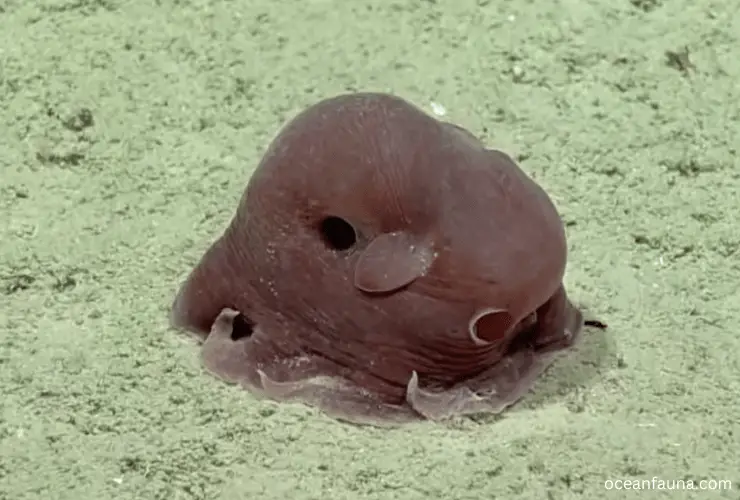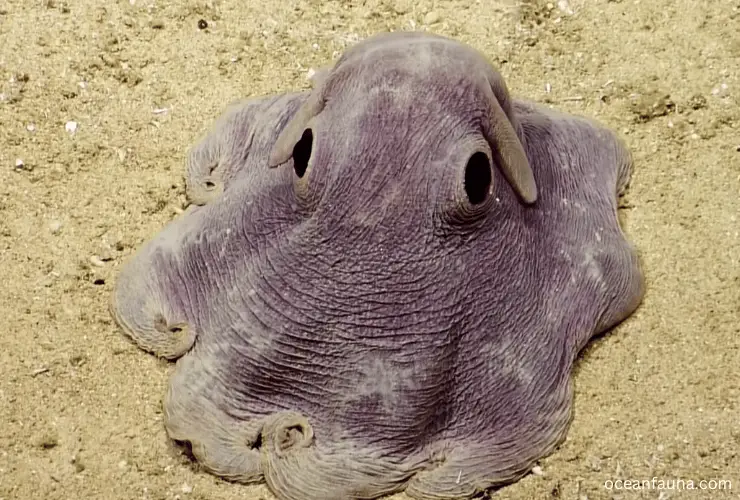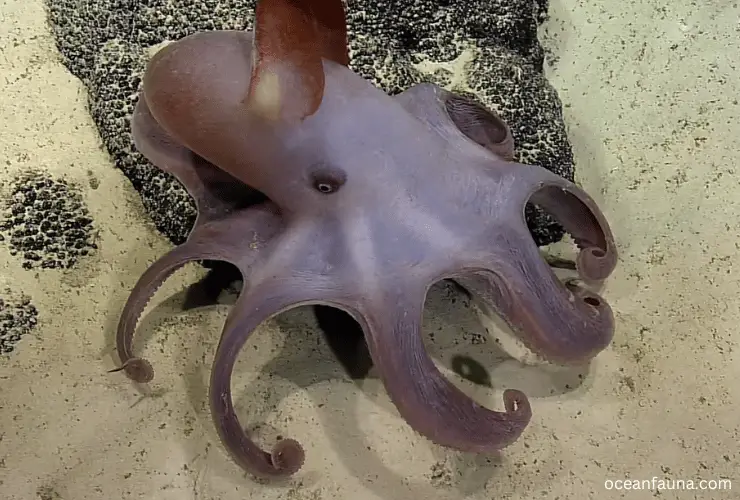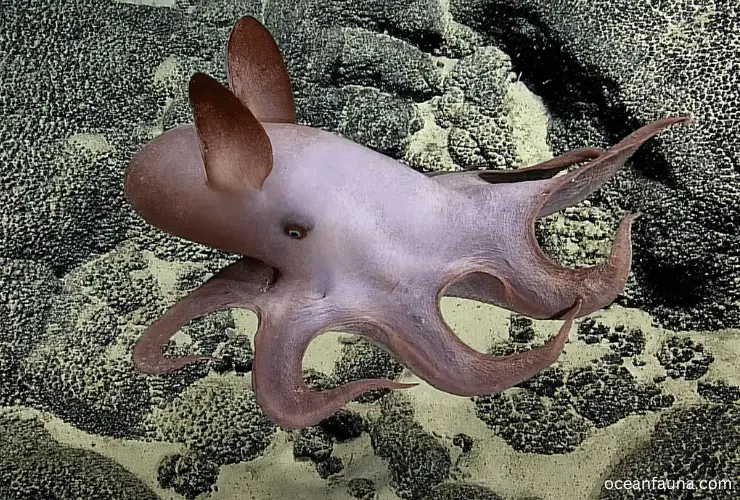Dumbo octopuses have a carnivorous diet, which consists of seizing and consuming their prey whole. They feed on copepods, isopods, bristle worms, and amphipods, with most of their food found near ocean vent ecosystems or in ocean currents.
In this article, I will discuss in detail the diet of the dumbo octopus. So, read on.
What Do Dumbo Octopuses Eat?
Dumbo octopuses are carnivores that feed on various small, bottom-dwelling organisms. They have a unique feeding method in which they seize and consume their prey whole. However, their dietary intake is limited to organisms that are 1-2 millimeters in size.
Their diet mainly comprises mollusks, such as tiny snails and bivalves, like oysters, and crustaceans, such as copepods, amphipods, and isopods. Besides, their diet may also include bristle worms, which are small, segmented marine worms.

The nutritional needs of the dumbo octopus are satisfied mainly by their prey consumption. These organisms are rich in protein, which is vital for building the octopus’s tissues and maintaining their overall bodily functions.
The mollusks and bivalves also provide the dumbo octopus with a substantial source of calcium, which is necessary for bone development and maintaining a healthy shell.
In addition to protein and calcium, the dumbo octopus requires other essential nutrients, such as vitamins and minerals, to support their growth and overall health. Algae, bacteria, and other microorganisms that are present in their prey’s digestive tract serve as a crucial source of these micronutrients for the dumbo octopus.
How Do Dumbo Octopuses Eat?
Dumbo octopuses have a unique feeding strategy that involves pouncing on their prey and consuming it whole. With their eight webbed tentacles, they can move swiftly through the water and easily capture their food.
Their diet primarily consists of copepods, isopods, bristle worms, and amphipods, which can be found in abundance around ocean vent ecosystems or floating along in the current.
When hunting for prey, dumbo octopuses will use their tentacles to sweep along the ocean floor or grab onto nearby objects to maintain their position in the water column. Once they have spotted a potential meal, they will rapidly propel themselves toward it using their muscular mantles.
Also Read: The Top 10 Dumbo Octopus Fun Facts
Their tentacles are specifically adapted for grasping and manipulating their prey. They are covered in tiny suckers that allow them to maintain a strong grip on their food while preventing it from escaping.
Dumbo octopuses also have two specialized tentacles that are longer than the others and are used to hold onto their prey while they eat.
When it comes time to consume their meal, dumbo octopuses simply engulf it whole. Their mouths are located at the center of their tentacles and are beaked in shape, which allows them to tear apart their prey before swallowing. As they consume their food, their powerful digestive system is able to break down even the toughest of prey items.
Why Does a Dumbo Octopus Eat as a Whole?
The reason why dumbo octopuses eat prey whole is due to the absence of the radula. This anatomical feature found in other octopuses resembles a tongue consisting of thousands of tiny teeth used for scraping or tearing prey.
Since dumbo octopuses lack this, they are unable to chew their prey, rendering them unable to consume it entirely.

These deep-sea creatures have a unique feeding mechanism. They usually open their beaks, which are situated at the center of their eight arms, and engulf their prey. This feeding process allows them to consume a variety of small, benthic crustaceans such as amphipods, isopods, and copepods.
Interestingly, dumbo octopuses have a high metabolism, which requires them to consume a significant amount of food to sustain their energy levels. Therefore, their feeding behavior of consuming prey whole allows them to maximize their essential nutrients and energy intake.
How Long Does a Dumbo Octopus Survive Without Food?
The dumbo octopus has a short lifespan and cannot survive for extended periods without food. They may be able to go up to a week without consuming any prey, but this will depend on the water temperature and their overall health.
In most cases, they are not able to survive longer than one week without food. Therefore, it is important for them to maintain a regular diet to sustain their health and keep them alive.
Do Dumbo Octopuses Eat Fish?
No, Dumbo octopuses do not eat fish. While there is a common misconception that Dumbo octopuses enjoy consuming cuttlefish, this is far from the truth. In reality, these fascinating creatures are unable to consume anything larger than 1-2 mm.
Dumbo octopuses are known to be primarily predatory, and their preferred prey consists of small, benthic crustaceans, including copepods, isopods, and amphipods. These tiny creatures are typically found in vast quantities around ocean vent ecosystems or drifting along in the natural current of the ocean.
Dumbo octopuses are not equipped to hunt fish as a regular part of their diet. Their mouths are relatively small and suited to seize and swallow only small prey items. They lack the lunging and biting mechanisms seen in other cephalopods, such as squids and cuttlefish, which are known to be more carnivorous.
Do Dumbo Octopuses Eat Crabs?
No, dumbo octopuses don’t eat crabs. They usually go for small and soft-bodied prey like copepods, isopods, and amphipods which are abundant in their habitat.
Due to their relatively small mouths, dumbo octopuses cannot consume prey items larger than 1-2mm. These creatures do not possess the lunging or biting mechanisms to effectively hunt and kill crabs, requiring a much larger mouth.
In some rare cases, dumbo octopuses have been observed consuming small crab larvae, but this is not a regular part of their diet.
Do Dumbo Octopuses Eat Plankton?
Yes, Dumbo octopi do indeed feed on plankton, specifically copepods. These small crustaceans make up part of the zoo-plankton family and are a primary food source for the Dumbo octopus.
To capture their prey, the Dumbo octopus will float to the surface at night when it is more difficult for predators like whale sharks and sea birds to see. Using its ear-shaped fins to propel itself through the water, the octopus will scope up the plankton as it passes by.

This feeding behavior is necessary for the survival of the Dumbo octopus, as it helps to provide the necessary nutrients and energy needed for growth and reproduction.
Additionally, feeding on copepods allows the octopus to avoid competition with other predators, such as larger fish and whales, which may feed on larger prey.
How the habitat of the dumbo octopus facilitates feeding?
The dumbo octopus is a small, deep-sea cephalopod known for its unique physical appearance and gentle demeanor. Its habitat lies at depths of up to 4,000 meters, where it feeds on various prey items.
One of how the habitat of the dumbo octopus facilitates feeding is through its physical characteristics. This cephalopod typically occupies soft seabed sediments, where its pliable body and eight appendages allow it to maneuver easily across the ocean floor.
This mobility is essential for the dumbo octopus to locate and capture prey, which often includes small crustaceans, worms, and other small invertebrates.
The deep-sea habitat of the dumbo octopus is also characterized by a relative lack of light and high pressure, which can lead to reduced visibility and impaired movement for some organisms.
However, the dumbo octopus has evolved adaptations to thrive in this environment. Its large, sensitive eyes enable it to detect bioluminescent prey items in low-light conditions, while its soft body allows it to withstand pressure changes.
Furthermore, the dumbo octopus exhibits a unique feeding behavior that facilitates its survival in this extreme environment.
Instead of using its arms to capture prey directly, it often hovers above the seafloor and extends its arms downward, creating a bell-shaped trap for passing prey to become ensnared. This technique conserves energy for the dumbo octopus and allows it to capture multiple prey items simultaneously.
Are There Any Predators of Dumbo Octopus?
The dumbo octopus, like all other creatures in the ocean, does have natural predators. Tuna, sharks, killer whales, and dolphins are some of the primary predators of the dumbo octopus. These marine creatures are known for their speed and agility in the water, making them formidable hunters even for the slow-moving octopus.
However, while the dumbo octopus has natural predators, it is not considered a primary food source for any of these predators. This may be because the dumbo octopus spends most of its time floating above the ocean floor, making it difficult for predators to locate and capture.
Despite this, the dumbo octopus can face potential dangers from other cephalopods, such as larger octopuses known to cannibalize their species.
Conclusion
Hopefully, you have detailed knowledge regarding the food habit of dumbo octopus. They are small, only about 8 inches, and eat small creatures such as plankton, copepods, worms, and other invertebrates that are no more than 2 mm in size.
If you want to know more or if you have any further queries
regarding this matter, let me know.


2 thoughts on “What Do Dumbo Octopuses Eat? [Explained]”